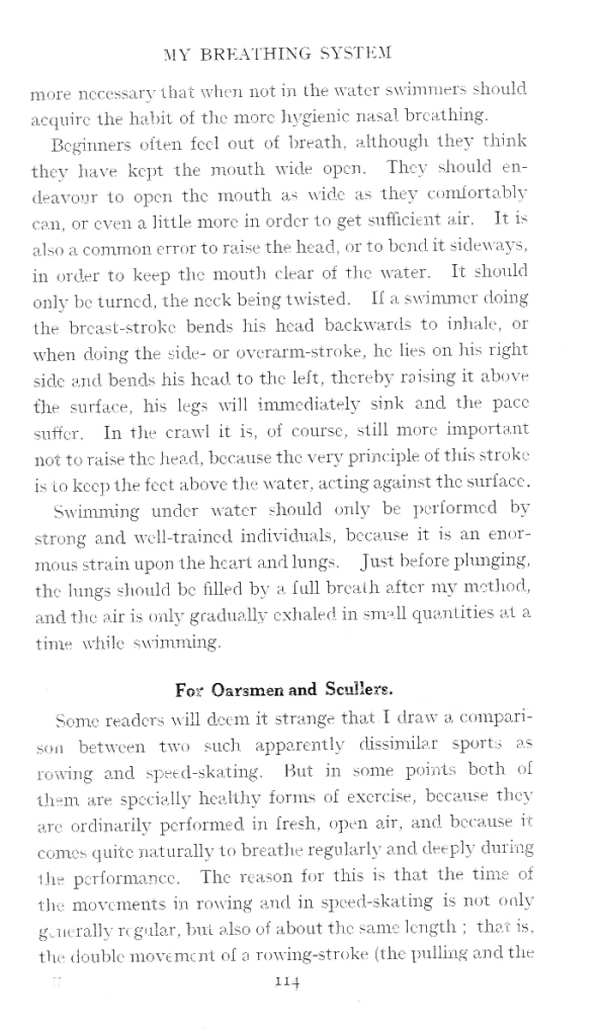48663 mbs 114

MY BRKATHIN<» SYST1CM
morę nccessary ihat wlicn notin the water swimnieis should actjuirc tlie habit of the morc hygienic nasal brcathing.
Bcgituiers often fccl out of breath, ahhough they think thcy liaw kcpt the mouth wide opon. Tlicy słiould en-deavour lo opon the mouth as wicie a> they comlortably can, or cvon a litlle morc in order to get suflicient air. It is also a comtnon error to rai.se the head. or to bend it sideways, in order to keep tlić mouth elear of tlie water. It should only be turnccl, the ncck being twisted. II a swimmer doing the brcasl-strokc bends his head baekwards to inJiale, or when doing the side- or overarm-stroke. he lies on his right side and bends his head to the left. thereby roising it aboM-flie surface, his legs will intmediately sink and the pace suffer. In the crawl it is, of course, ~till morc important not to raise the Jiead. bccause the v erv principle of this stroke is to keej) the fect above the water, actingagainst the surface.
Swinuning under water should only be performed by strong and well-traincd individnals, bccause it is an enor-mons strain upon the hcarl and lungs. Just before plunging, the lungs should be lilled by a fuli breatli after my method, and the air i? only gradually cxhaled. in sm-*ll quanlities at a tiule whilo swimming.
For Oarsmen and Scullers.
Sonie readers will dccni it strangę that I draw a eompari-soii between two such apparently dissimilar sport. as rowing and speed-skating. But in sonie points both ol Ulem are spccially healthy forms of excrcise, bccause thcy aro ordinarily performed in fresh, open air. and bccause it comes quitc naturally to breatlie regularly and deeply during ! lir performance. The reason for this is that tlie time of the morcinents in rowing and in speed-skaling is not only g.iu rally r< galar, bul also of about the same lcngth : that is. the double movemcnt of a rowing-stroke (the pulling and the
iM
Wyszukiwarka
Podobne podstrony:
mbs 034 MY BRKATHI.YG SYSTEM other in a detinite space of time, and on the grcater or shorter durati
mbs 100 MY BRKATHING SYSTEM EXERCISE No. 8. Fuli breathing during arm-raising sideways and subsecjue
mbs 041 MY BRKATHTSG SYSTKM simultaneously severely condemning the use of all the rest Sometimes exc
mbs 045 MY BRKATHINTt SYSTEM our breathing ? ” The author (Dr. Hulbert) submits that this is accompl
mbs 076 MY BRKATHING SYSTEM in the tuition of all tcchiiical points of a gamę, but they very, verv s
88494 mbs 026 MY BRKATHING SYSTEM sufter from an almost unąuenchable thirst. This produces a habit o
więcej podobnych podstron